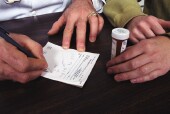- Navigating Your Midlife Crisis: Embracing New Possibilities
- City Raccoons Showing Signs of Domestication
- Mapping the Exposome: Science Broadens Focus to Environmental Disease Triggers
- One Week Less on Social Media Linked to Better Mental Health
- Your Brain Changes in Stages as You Age, Study Finds
- Some Suicide Victims Show No Typical Warning Signs, Study Finds
- ByHeart Formula Faces Lawsuits After Babies Sickened With Botulism
- Switch to Vegan Diet Could Cut Your Greenhouse Gas Emissions in Half
- Regular Bedtime Does Wonders for Blood Pressure
- Dining Alone Could Mean Worse Nutrition for Seniors
Routine Heart Care Similar From Nurse Practitioners, Doctors: Study


, Many patients with chronic heart disease will receive the same quality of care from a nurse practitioner or physician assistant as they would from a doctor, a new study suggests.
That’s good news because the recent expansion of U.S. health coverage has many public health experts warning of a future with too few doctors for the patients on hand.
“With the passage of the Affordable Care Act, we are looking at 34 million new patients entering the system with new coverage by 2016,” said study lead author Dr. Salim Virani, an investigator with the Veterans Affairs (VA) Medical Center in Houston. “The estimates are that by 2020 we will have a shortfall of 45,000 primary care doctors and 45,000 specialists, rising to 130,000 doctors by 2025.”
This begs the question, he said, as to how the short-handed health care system will handle this influx of patients.
Shortages of heart doctors, in particular, are a priority and “a hot topic for many state legislators and policymakers,” said Dr. Brahmajee Nallamothu, a spokesman for the American Heart Association.
Increased use of nurse practitioners and physician assistants is one attempt to close the gap — one that builds on the idea of team-based medicine, said Nallamothu, an associate professor of internal medicine at the University of Michigan in Ann Arbor.
For this study, Virani’s team compared the delivery of routine cardiovascular disease care by physicians and non-physicians.
“What we found is that for the basic concerns, the quality of overall care was fairly comparable,” Virani said.
The findings were published online May 1 in Circulation: Cardiovascular Quality and Outcomes.
While traditional nurses cannot prescribe medicine or provide patient care on their own, nurse practitioners and physician assistants undergo extra training that allows provision of a broader range of services, he explained. For instance, in some places, they can conduct routine physical exams and write prescriptions.
And although most nurse practitioners and physician assistants work under a physician’s guidance, in 19 states, one or both can function independently of a supervising doctor, he said.
For this study, investigators evaluated the care of heart patients seen at 130 VA facilities between 2013 and 2014. Nearly 935,000 patients were attended to by physicians, while more than 252,000 were seen by either a nurse practitioner or physician assistant.
All had a history of heart attack, stroke, arterial blockage and/or stent surgery. But all were deemed “stable” outpatients during the study time-frame.
All were seen in a primary care setting (rather than by specialists), and the analysis focused solely on three heart health services: blood pressure monitoring and control; cholesterol control; and statin and beta-blocker prescriptions and adherence.
Overall, only about 54 percent of patients had all three measures of care appropriately handled, the researchers found.
“However, in terms of who was attending patients, we saw only small differences in the quality of care here and there, and the differences were not statistically significant,” Virani said.
“While there’s clearly a lot of work to be done in terms of improving effective care delivery for all cardiovascular disease patients, the delivery of basic services is comparable among both physicians and non-physicians,” he added.
Virani cautioned, however, that the study does not speak to situations involving “crisis” care. “If patients are not stable and have any cardiac symptoms that we did not look at, we just don’t know yet how they do if cared for by a non-physician provider,” he warned.
Nallamothu said the VA study findings seem to support use of physician assistants or nurse practitioners in terms of typical quality measures.
However, he added, it’s not known if the study findings would hold true in non-VA settings, since the roles of nurse practitioners and physician assistants vary from state to state. That could be explored, he said.
More information
There’s more on heart disease treatment at the U.S. National Heart, Lung, and Blood Institute.
Source: HealthDay
Copyright © 2025 HealthDay. All rights reserved.










